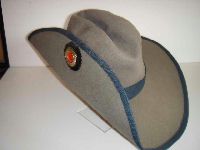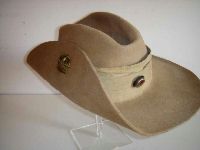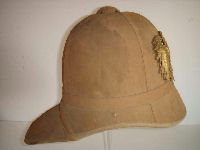|
Figure 1 is based on a wartime photograph of
a Württemberg Landsturmman on home guard duties. The original photograph
shows three former Schutztruppe serving in the XIII/19th Battalion Württemberg
Landsturm (or reserve). The only unusual thing about the photo is that they are
wearing their Schutztruppe Südwester Slouch Hats with blue piping and hatbands
for South West Africa rather than the prescribed Landsturm headgear (1813
Oilskin caps or obsolete Jäger style shakos). It is very rare to see colonial
items worn by the home army but it did happen on occasion. Aside from this
single item he is dressed typically for Landsturm other ranks. He wears a
modified M1910 field grey tunic with plain cuffs, piped in red for infantry. The
shoulder straps are plain blue while the front of the collar displays the Army
Corps (XIII) and battalion number (19) in brass. He carries blackened leather
equipment with one set of M1909 ammunition pouches. |

SW African Schutztruppe Südwester
(See
Südwester
Details Page)
Photo Copyright Damien Doppler |
|
Figure 2 is based on a
photograph of an Officer of the Afghan Expedition led by a Bavarian
Artillery Officer, Oskar von Niedermeyer in 1915-16. The expedition travelled
overland on a dangerous and gruelling march through Persia to Afghanistan
avoiding British and Russian patrols to convince Emir Habibullah of Afghanistan
to join the Central Powers. This would, they hoped, disrupt Russian and British Indian interests
in the area and force the Entente to withdraw troops from other fronts. They ultimately failed to
convince the Afghans (who were cleverly accepting bribes from both sides while
remaining neutral) to join the war and eventually left Kabul empty handed.
In addition to the original small military contingent (many of whom had former
colonial or Asian experience) the expedition consisted of a diplomatic corps
headed by Otto von Hentig, some former Indian army POWs and nationalists who had
joined the German cause to free India from British rule, Persian tribesmen
employed as guards and guides and several German and Austrian POWs who had escaped
camps in Russian Central Asia and teamed up with Niedermeyer.
Curiously Niedermeyer and his
original military cadre were kitted out in stocks of German South West African Police uniforms
(see South West African
Police Page) as well as additional items of private purchase and local supplies. This officer
wears a South West African Police slouch hat (pinned up at the right side with a
brass Imperial Crown- although in photos Niedermeyer himself doesn't pin his hat
up), police tunic (featuring the distinctive green collar but without
insignia or cuff braiding) worn open at the collar and khaki cord riding breeches.
He carries two pistols, one of which is a naval issue long pistol. The bandolier and rifle appear to
be private purchase items.
|

SW African Police Südwester
(See
Südwester
Details Page)
Photo Copyright Damien Doppler |
|
Figure 3 is based on a
photograph of an Artillery NCO in Macedonia 1917. When the Army Group Scholz
was sent to back up Bulgarian forces in Macedonia many of the troops were issued
lightweight cotton khaki uniforms from surplus East Asian Expeditionary Corps
stocks. This NCO from a mortar (Minenwerfer) unit has a complete uniform
(stripped of shoulder straps) from those supplies including tropical helmet with brass imperial eagle. The
dark band across the helmet is to indicate arm-of-service (in this case black
edged with red for artillery and pioneers) and the helmet
may or may not have had a large imperial (black/white/red) cockade on the left
side, as worn commonly by the East Asian Expeditionary Corps. The
single lace on the upper edge of the standing collar identifies him as an Unteroffizier.
He wears an Iron Cross Second class as a small ribbon on his left breast. Apart
from his tropical uniform he wears standard European issue field grey puttees,
marching boots, blackened leather equipment with a plain dull grey belt buckle
and a small pistol. |

East Asian Tropical Helmet
(See
Tropical Helmets
Details Page)
Photo Copyright Damien Doppler |